Issue Archive
Table of Contents
BLOOD COMMENTARIES
REVIEW ARTICLE
Always stressed but never exhausted: how stem cells in myeloid neoplasms avoid extinction in inflammatory conditions
While acute and chronic inflammation can cause loss of normal hematopoietic stem cells and lead to hematopoietic failure, they have an opposite impact on myeloproliferative neoplasm stem cells (MPN SCs), driving progression to myeloid malignancy. Zhao and Deininger review the current understanding of the mechanisms by which MPN SCs preserve dormancy to avoid stem cell exhaustion, which may provide insight for noncytoreductive control of MPN cell proliferation.
HOW I TREAT
How I treat AML incorporating the updated classifications and guidelines
The European LeukemiaNet guidelines, the World Health Organization classification, and the International Consensus Classification have all been recently updated to provide new guidance on classification reflecting molecular abnormalities, risk stratification, prognosis, response assessment, and measurable residual disease monitoring for patients with acute myeloid leukemia (AML). In a timely How I Treat article, El Chaer et al use 4 illustrative cases to discuss how changes in these classification systems and guidelines influence clinical decision making.
LYMPHOID NEOPLASIA
Activated granulocytes and inflammatory cytokine signaling drive T-cell lymphoma progression and disease symptoms
Jaeger et al elucidated the role of neutrophils in peripheral T-cell lymphomas with a strong inflammatory phenotype. The authors focused on follicular T-cell lymphoma (T-follicular helper type). They show that these tumors induce inflammation and neutrophil expansion accompanied by marked cytokine release. Depletion of neutrophils, removal of interleukin-6, and inhibition of JAK-STAT signaling with ruxolitinib all reduced inflammation and tumor progression.
CDK7 controls E2F- and MYC-driven proliferative and metabolic vulnerabilities in multiple myeloma
Yao et al explored the mechanism by which CDK7 inhibition mediates multiple myeloma (MM) cell death. They demonstrate that CDK7 expression is correlated with E2F and MYC transcriptional pathways in cells of patients with MM. CDK7 inhibition blocked E2F activity by interrupting the CDK/Rb axis and decreased MYC-regulated metabolic pathways. In primary cells and myeloma mouse models, a small-molecule CDK7 inhibitor killed myeloma cells in vitro and in vivo, suggesting that it is a promising target for clinical treatment of MM.
MYELOID NEOPLASIA
The clinical picture of ERCC6L2 disease: from bone marrow failure to acute leukemia
Clinical Trials & Observations
Hakkarainen and colleagues describe the natural history of ERCC6L2 disease, a rare homozygous disorder that predisposes to bone marrow failure (BMF) and myeloid malignancies associated with concomitant somatic TP53-mutated clones. They present a retrospective study of 52 patients from 35 families, demonstrating that patients with myelodysplasia have mild cytopenias that belie severe hypoplasia and that progression from BMF to myeloid malignancy is associated with increasing TP53 mutant variant allele fraction and very poor prognosis.
PLATELETS AND THROMBOPOIESIS
Prolonged response after TPO-RA discontinuation in primary ITP: results of a prospective multicenter study
Clinical Trials & Observations
Guillet et al present results of thrombopoietin receptor agonist (TPO-RA) discontinuation in a selected population of patients with persistent or chronic immune thrombocytopenia (ITP). They report that in patients in stable remission with a platelet count of >100 × 109/L for at least 2 months (48 of 388 patients), 56% maintained a platelet count of >30 × 109/L off therapy. This suggests that a subset of patients on chronic treatment with TPO-RA can be successfully tapered off therapy.
RED CELLS, IRON, AND ERYTHROPOIESIS

Activation of mTORC1 in villous duodenal macrophages induces the expression of serine protease, which locally degrade Trasferrin to inhibit efficient iron export from enterocytes.
Duodenal macrophages control dietary iron absorption via local degradation of transferrin
Sukhbaatar and colleagues investigated the role of mTORC1 signaling in iron metabolism. They report a novel pathway regulating iron metabolism, demonstrating that mTORC1 regulates macrophages in the lamina propria to induce local degradation of transferrin, limiting iron transfer from intestinal epithelial cells by decreasing availability of transferrin.
THROMBOSIS AND HEMOSTASIS
Efficacy of platelet-inspired hemostatic nanoparticles on bleeding in von Willebrand disease murine models
Roullet et al describe a novel approach to the treatment of von Willebrand disease (VWD) using synthetic platelet nanoparticles to bridge von Willebrand factor, collagen, and activated platelets. This preclinical study showed improvement of clotting with microfluidic assays and reduced bleeding in a murine model of VWD.
TRANSPLANTATION
Impact of TP53 on outcome of patients with myelofibrosis undergoing hematopoietic stem cell transplantation
Clinical Trials & Observations
Mutations in TP53 are associated with poor prognosis in many hematologic malignancies. Gagelmann et al confirmed that this is also true for patients with myelofibrosis who undergo hematopoietic stem cell transplantation. In an analysis of 349 patients, 49 had TP53 mutations, and 30 of the 49 had multihit mutations. As with patients with acute leukemia, patients with single-hit mutations have survival rates similar to those with wild-type TP53. However, patients with multihit TP53 mutations have a shorter time to leukemic transformation and a markedly reduced median survival (1.5 years vs 13.5 years with wild-type TP53).
BLOOD WORK
-
Cover Image
Cover Image
![issue cover]()
Prussian blue–stained duodenum from a Tsc2fl/fl Lyz2cre/+ mouse. Notice the iron stored in the enterocytes that is unable to efficiently enter the circulation due to the local degradation of transferrin by mTORC1-activated lamina propria macrophages. See the article by Sukhbaatar et al on page 2878.
- PDF Icon Front MatterFront Matter
- PDF Icon Table of ContentsTable of Contents
- PDF Icon Back MatterBack Matter
- PDF Icon Editorial BoardEditorial Board
Advertisement intended for health care professionals
Email alerts
Advertisement intended for health care professionals

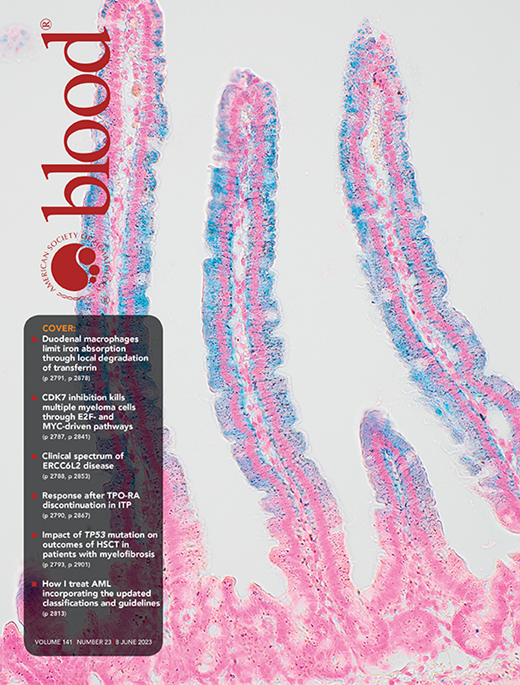



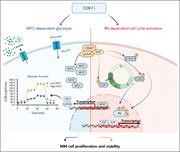
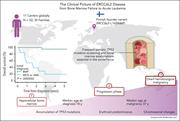
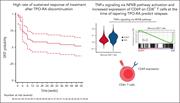


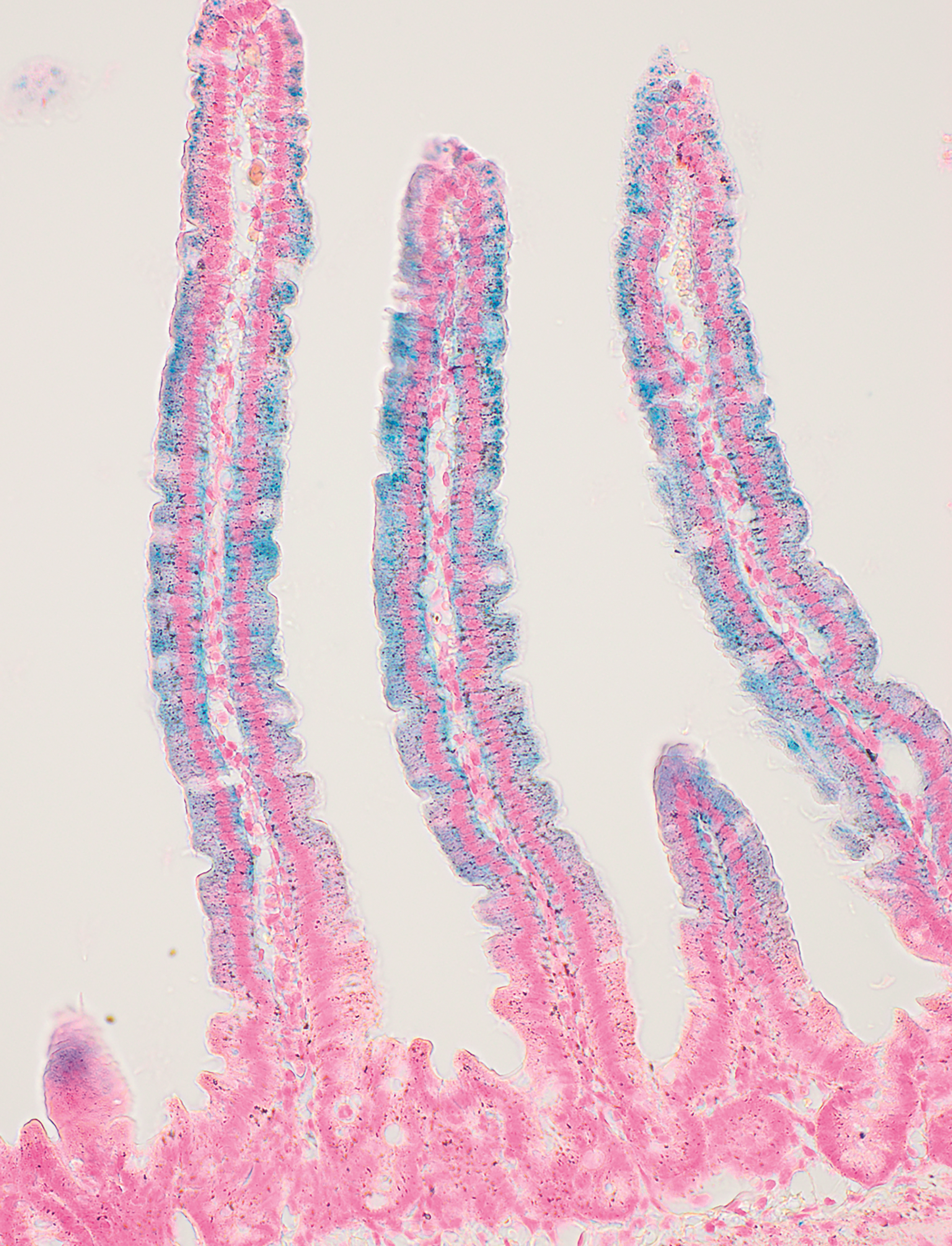
Starving multiple myeloma cells via CDK7 inhibition